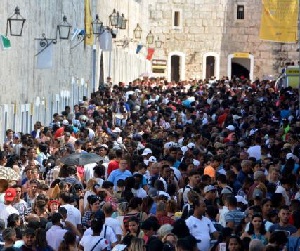 Attempts to hold a Book Fair in Havana date back to the Republican era, when, in May of 1937, the first event of this kind was organized, a promotional affair held on the La Punta esplanade, where the Malecon meets Paseo del Prado. The main promoters of the idea were Emilio Roig de Leuchsenring and José Luciano Franco, who, with great effort, managed to involve a representation of the main Havana bookstores and publishing houses of the time.
Attempts to hold a Book Fair in Havana date back to the Republican era, when, in May of 1937, the first event of this kind was organized, a promotional affair held on the La Punta esplanade, where the Malecon meets Paseo del Prado. The main promoters of the idea were Emilio Roig de Leuchsenring and José Luciano Franco, who, with great effort, managed to involve a representation of the main Havana bookstores and publishing houses of the time.
The event, officially backed by the government, was inaugurated by the city’s mayor, Antonio Beruff Mendieta, and closed by the Ministry of Education’s director of Culture, Dr. José María Chacón y Calvo. In spite of its ambitions, the project did not capture much attention in the media, drawing a disappointing number of visitors. It was a time to accept subjugation, not to read.
Books were a privilege for those born with financial resources; on the other hand, illiteracy was rampant throughout the country. Most Cubans could not even dream of discovering in the pages of literary works any light hidden from the poor. With the triumph of the Revolution and the elimination of chronic illiteracy, along with the creation of the National Publishing House on March 31, 1959, under the wise direction of Alejo Carpentier, books finally reached even the most remote corners of the nation.
Sixty-two years later, the Cuban Book Institute has called for celebrations today and evaluations of everything that has been done and what remains to be done in terms of publication and promotion of books in Cuba.
The path, which began with a mass run of a million copies of Don Quixote, can be seen today, with legitimate pride, in the thousands of titles and authors which fill the collections of Cuban publishing houses, because in Cuba reading is a feast for our minds and an irrevocable right of the entire population, especially children and youth.
(Taken from Granma)